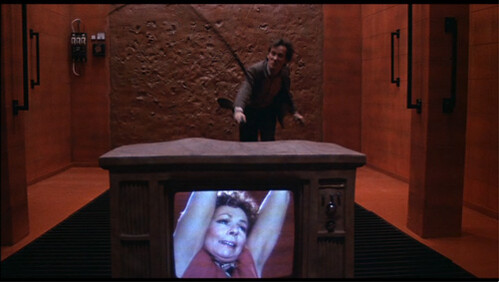
I've never been much of a David Cronenberg fan. I've enjoyed his stuff on the periphery, with late '80s efforts like The Fly
Videodrome was a film of his I had never seen. Made in 1983, I had the impression that it, along with other earlier efforts like Scanners
Upon viewing the film, I would have to say that yes, he was. Incredibly so.
Videodrome looks to be the flashpoint where modern horror truly began. With its use of stylized video images, it points the way to the media obsessions the genre would adopt in the new century. The poison video tape in The Ring
Unfortunately, I'm not that impressed with the movie itself. Videodrome has its moments, but its ideas exceed its execution. The narrative feels disjointed, particularly at its climax, and Cronenberg tries to cheat his way out of explaining things by piling on the gore. We'll be so ooged out by the big vagina that has opened up in James Woods' stomach, we won't necessarily notice that the story doesn't always make sense or that the psychology is a little obvious.
Which can often work. Horror movie is about inspiring reactions, after all, and in its day, Videodrome may have scared the beejezus out of people. From watching the second disc's making-of documentary, Rick Baker's effects for the movie were certainly innovative for their day. Twenty-one years later, though, they no longer have the ability to maintain their sense of realism. Woods' malformations ooze and spit in ways that call too much attention to themselves, as, once again, the more ickiness Baker dumps out, the less obvious the fakeness is--the same trick Cronenberg uses. The neatest effect, the melding of man and TV fares better. I was able to ignore the fact that it was obviously a big balloon just because it was so damn cool.
Criterion has put together an amazing package, to my mind far exceeding what Videodrome deserves. The discs contain two commentaries, a recent short film by Cronenberg, various documentaries, collections of photos, and a vintage discussion on horror between John Landis, John Carpenter, and Cronenberg shot while Videodrome was in production. I can't imagine why anyone would want the unedited films that comprise the fictional Videodrome TV show, though. I would think you'd have to have a rather grisly brain malfunction to want to sit through their extended torture scenes.
The neatest feature, though, may be the package itself. It's designed to look like an old VHS tape--the Videodrome tape--including a paper slip cover and a spine made-up to resemble a handwritten label. It's a perfect melding of design and theme, keeping in the spirit of the film. There is also a 40-page booklet of photos, credits, and extensive essays.
I am sure fans of this sort of thing will appreciate it more than I, and Criterion once again sets the standard for how a movie should be treated (great sound, great picture, great extras), but in the end, for this viewer, Videodrome doesn't live up to its reputation.


No comments:
Post a Comment